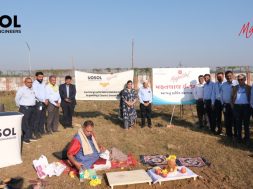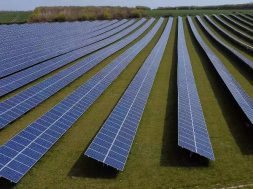
Photovoltaic Industry Price Trend: Polysilicon and Wafer Prices Rise Marginally while Cell Cost and Inventory Elevate Amidst Continuous Bargaining
Polysilicon quotations continued to rise this week, with low price resources gradually diminished. With most mainstream polysilicon businesses signing the long-term orders for April earlier this month, there was no mass amount of spots available for transactions this week, and mainstream market quotations had been slightly upward adjusted, followed by a gradually diminishing level of low price resources and a marginal increase in the basic price. Sporadic orders were concluded at roughly RMB 135/kg, and the average price of multi polysilicon remained at the same level as last week at RMB 74/kg. The continuous ascension in the domestic prices of mono and multi polysilicon has prompted the global average price of polysilicon to US$16.416/kg.
An observation on the production, operation, and shipment status of the polysilicon sector indicates that two businesses in Xinjiang among 10 domestic polysilicon businesses have begun implementing equipment overhaul and maintenance, which has derived a certain degree of impact for the overall domestic output, where the domestic production and import volume is expected to remain constant to last month. Judging by the current development, a differentiation has been seen from the actual supply status of domestic polysilicon businesses during the first half of 2021 primarily owing to the impact from the flourishing downstream demand. Businesses have maintained on a high level of operating rate since the first quarter, where partial production bases in Xinjiang and Inner Mongolia are also climbing in production capacity, and on the other hand, a number of businesses are lowering on the load of production in stages due to the policy control, equipment maintenance, and the respective planning in production schedules, which resulted in an actual output level that is lower than the expectation. The increase in the volume of polysilicon is expected to occur in the second half of the year, though the demand for the capacity expansion of the downstream wafer sector that will be much larger than that of what the polysilicon market will offer, together with the stocking mentality of businesses, are going to contribute to the continuous excess demand status of polysilicon, and the overall polysilicon prices may remain on the rising trend.
Wafers
Wafer quotations were fully adjusted this week, and leading wafer businesses had readjusted the quotations for April this week at a rise of roughly 8% after the continuous increase in polysilicon quotations over the past two weeks. The rise of polysilicon prices has actuated an overall elevation in the prices of mono and multi-Si wafers, where the average prices of G1 and M6 mono-Si wafers are now sitting at RMB 3.75/pc and RMB 3.85/pc, whereas M10 wafer remains sturdy at RMB 4.54/pc as businesses of main shipment have yet to disclose the new list prices, and G12 wafer has been upward adjusted to RMB 6.33/pc in quotation under a comparatively minor degree of inflation. Pertaining to multi-Si wafers, the domestic and overseas average prices have been upward adjusted to RMB 1.72/pc and US$0.233/pc respectively thanks to the marginal recovery in demand generated by the end sector.
As observed from the status of the wafer market, the primary reason for the sizeable inflation in mono-Si wafers this time lies on the elevation of polysilicon prices, which significantly increased the production cost for wafer businesses, who are now forced to transfer the cost through adjustments on wafer prices, and the robust demand of the cell market on wafers has also triggered a relatively constrained status in wafer products that stabilizes the overall high level of mono-Si wafers. However, partial downstream businesses are adhering to a wait-and-see attitude after the inflation from the market this week, and the overall transaction volume of wafers was comparatively smaller.
Cells
Cell quotations remained stable on the weaker end this week, and partial businesses may reduce on the operating rate, especially with how the cost of cell businesses have elevated subsequent to the continuous inflation of wafers this week, where a number of mainstream businesses are releasing signals regarding a rise in cell prices, which resulted in the downstream sector commenting on a cautious procurement or upholding a wait-and-see attitude. Cell businesses have converted on the sizes of cells alongside the progressive decline in the demand for mono-Si G1 cells from the end sector, and the demand for the overall capacity of G1 that is currently on the lower end is mainly focused on overseas orders. The downstream sector has decelerated on the stocking of M6 cells after inflation due to the overall higher production volume, and the relevant inventory continues to accumulate. G1 and M6 mono-Si cells are currently sitting at RMB 0.89/pc and RMB 0.85/pc respectively in average price, whereas M10 and G12 large-sized cells are now RMB 0.9/pc and RMB 0.91/pc respectively in average price amidst the stabilized large-sized market.
The supply of the multi-Si cell market is relatively tight under the restricted supply of the relevant capacity and the improved overseas demand, where the domestic and overseas prices are maintained at RMB 0.63/pc and US$0.085/pc as first-tier businesses remain robust in quotations.
The upward adjusted quotations for the cell market owing to the ascending cost are not accepted by downstream clients, which explains the apparent pressure from accumulated inventory this week, and the reduction in operating rate for partial businesses. Most cell businesses are currently operating on cash cost, and are no longer able to sustain the inflation of wafers. A further reduction in the operating rate of the cell market may occur in the near future.
Modules
Module quotations were predominantly stable this week, where the quotations for partial SME makers had fallen back marginally. Module costs are now given a breathing room benefitting from the drastic reduction in glass quotations, and a number of SME makers are more flexible in the maneuvering of quotations, with different figures seen each day, whereas mainstream module makers are adhering to sturdy quotations. The average prices of the 325-335W/395-405W and the 355-365/425-435W mono-Si modules are currently sitting at RMB 1.59/W and RMB 1.65/W respectively. Several cell businesses are attempting to follow up on the considerable increment in the upstream wafer quotations last week, though the module sector is expressing unwillingness.
The end market is not too lenient on the elevated module prices during the first quarter. With a relatively tight schedule of establishment between the second and third quarter, as well as the gradual release of demand for projects that are comparatively superior in profitability, and the decelerated dynamics in inventory pull for the overseas market due to the rise in module cost, the end demand from the domestic market has not lived up to the expectation during the second quarter. The overall transaction status of the market is slightly sluggish under the steadily increasing level of inventory in the module market, where module makers are unable to sustain high costs, and the utilization rate for module makers will remain lethargic within the short term, which may decelerate the production expansion for partial makers.
Glass prices are overall stabilized this week, where 3.2mm and 2.0mm glasses are now sitting at RMB 27-30/㎡ and roughly RMB 20-22/㎡. Module makers have successively commented on the inability of sustaining the high cost of auxiliary materials in the face of depleted demand from the end sector, and glass prices have weakened in April, while partial photovoltaic glass suppliers that are weaker in bargaining power are willing to forfeit on a small degree of profit.
















